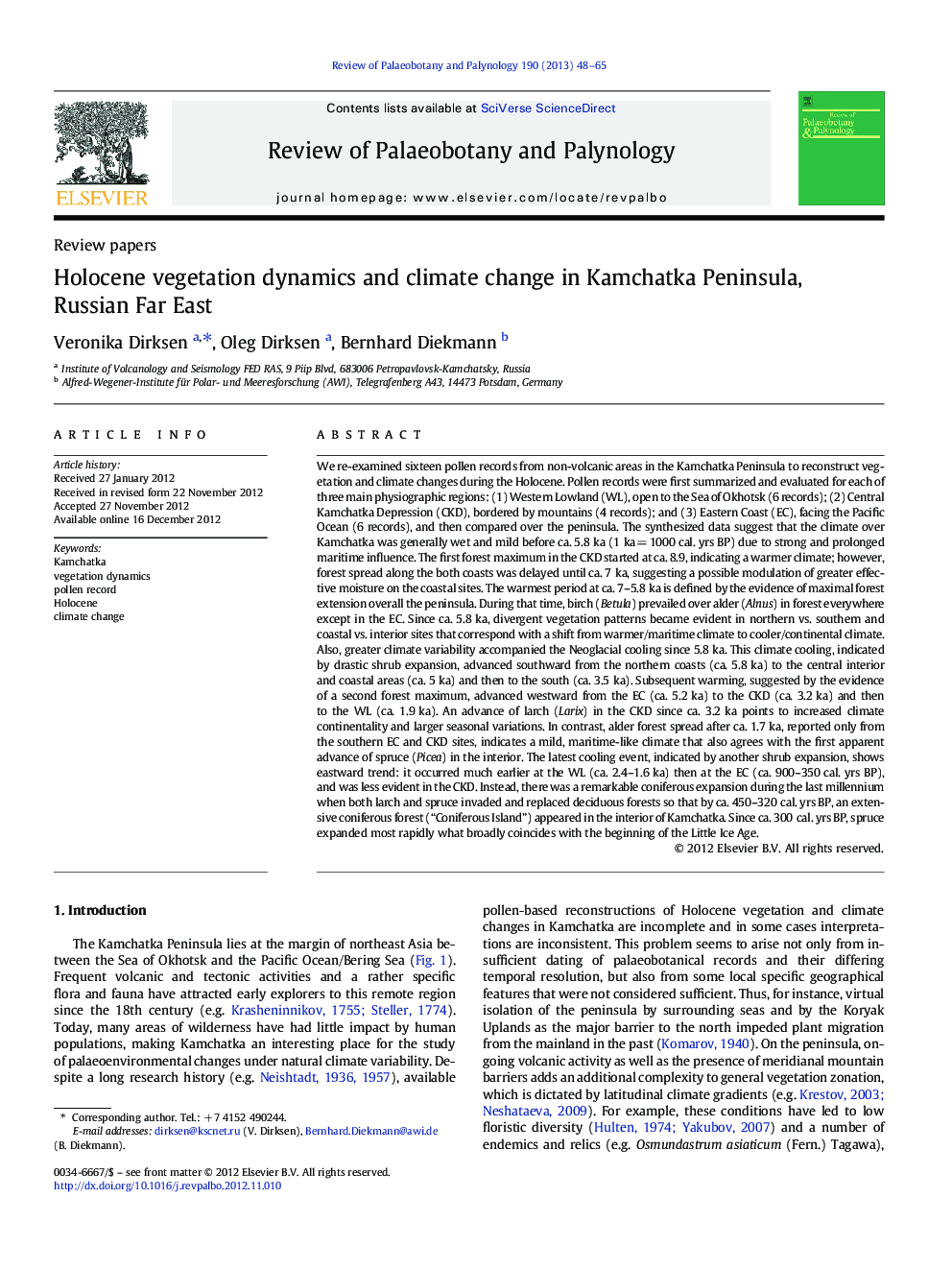| کد مقاله | کد نشریه | سال انتشار | مقاله انگلیسی | نسخه تمام متن |
|---|---|---|---|---|
| 4750449 | 1642508 | 2013 | 18 صفحه PDF | دانلود رایگان |

We re-examined sixteen pollen records from non-volcanic areas in the Kamchatka Peninsula to reconstruct vegetation and climate changes during the Holocene. Pollen records were first summarized and evaluated for each of three main physiographic regions: (1) Western Lowland (WL), open to the Sea of Okhotsk (6 records); (2) Central Kamchatka Depression (CKD), bordered by mountains (4 records); and (3) Eastern Coast (EC), facing the Pacific Ocean (6 records), and then compared over the peninsula. The synthesized data suggest that the climate over Kamchatka was generally wet and mild before ca. 5.8 ka (1 ka = 1000 cal. yrs BP) due to strong and prolonged maritime influence. The first forest maximum in the CKD started at ca. 8.9, indicating a warmer climate; however, forest spread along the both coasts was delayed until ca. 7 ka, suggesting a possible modulation of greater effective moisture on the coastal sites. The warmest period at ca. 7–5.8 ka is defined by the evidence of maximal forest extension overall the peninsula. During that time, birch (Betula) prevailed over alder (Alnus) in forest everywhere except in the EC. Since ca. 5.8 ka, divergent vegetation patterns became evident in northern vs. southern and coastal vs. interior sites that correspond with a shift from warmer/maritime climate to cooler/continental climate. Also, greater climate variability accompanied the Neoglacial cooling since 5.8 ka. This climate cooling, indicated by drastic shrub expansion, advanced southward from the northern coasts (ca. 5.8 ka) to the central interior and coastal areas (ca. 5 ka) and then to the south (ca. 3.5 ka). Subsequent warming, suggested by the evidence of a second forest maximum, advanced westward from the EC (ca. 5.2 ka) to the CKD (ca. 3.2 ka) and then to the WL (ca. 1.9 ka). An advance of larch (Larix) in the CKD since ca. 3.2 ka points to increased climate continentality and larger seasonal variations. In contrast, alder forest spread after ca. 1.7 ka, reported only from the southern EC and CKD sites, indicates a mild, maritime-like climate that also agrees with the first apparent advance of spruce (Picea) in the interior. The latest cooling event, indicated by another shrub expansion, shows eastward trend: it occurred much earlier at the WL (ca. 2.4–1.6 ka) then at the EC (ca. 900–350 cal. yrs BP), and was less evident in the CKD. Instead, there was a remarkable coniferous expansion during the last millennium when both larch and spruce invaded and replaced deciduous forests so that by ca. 450–320 cal. yrs BP, an extensive coniferous forest (“Coniferous Island”) appeared in the interior of Kamchatka. Since ca. 300 cal. yrs BP, spruce expanded most rapidly what broadly coincides with the beginning of the Little Ice Age.
► 16 pollen records are reviewed from the Kamchatka Peninsula, Russian Far East.
► We reconstruct vegetation dynamics during the Holocene.
► We outline the Holocene climate changes in Kamchatka.
Journal: Review of Palaeobotany and Palynology - Volume 190, 15 March 2013, Pages 48–65